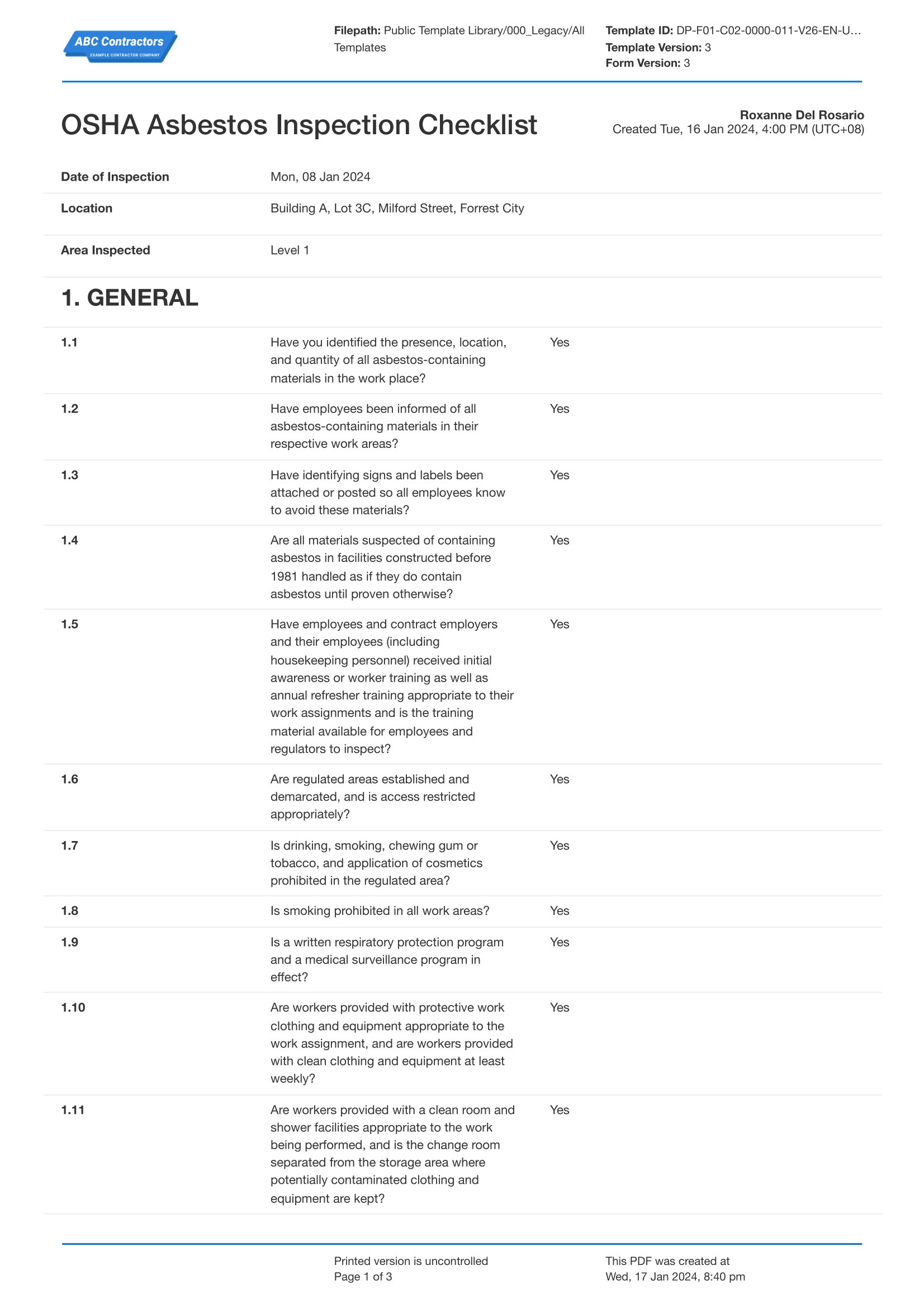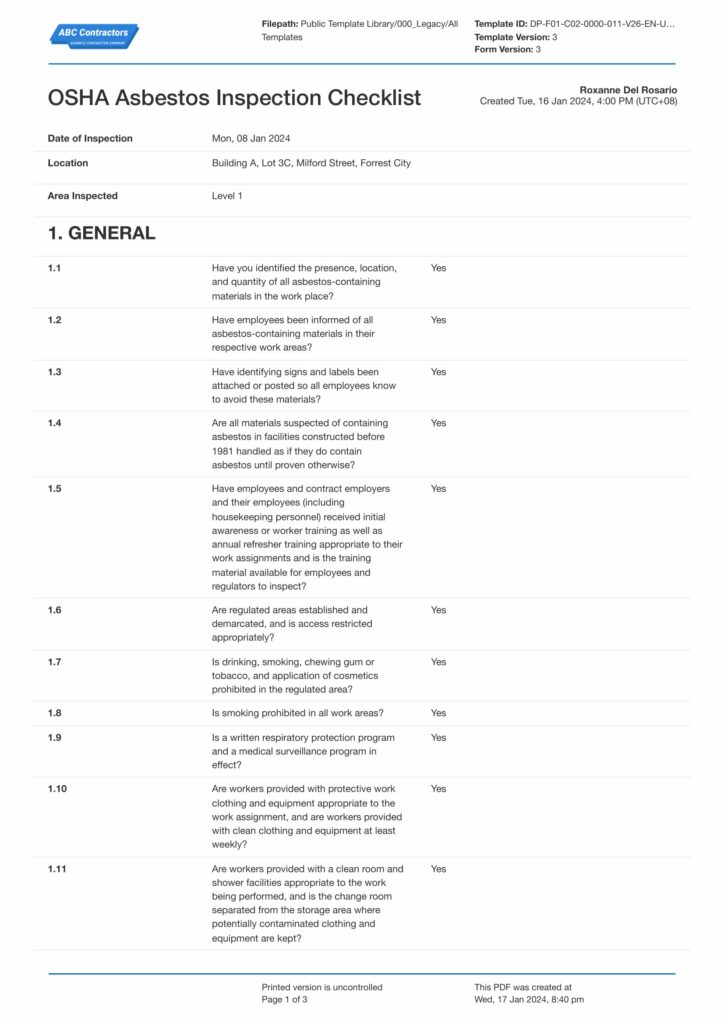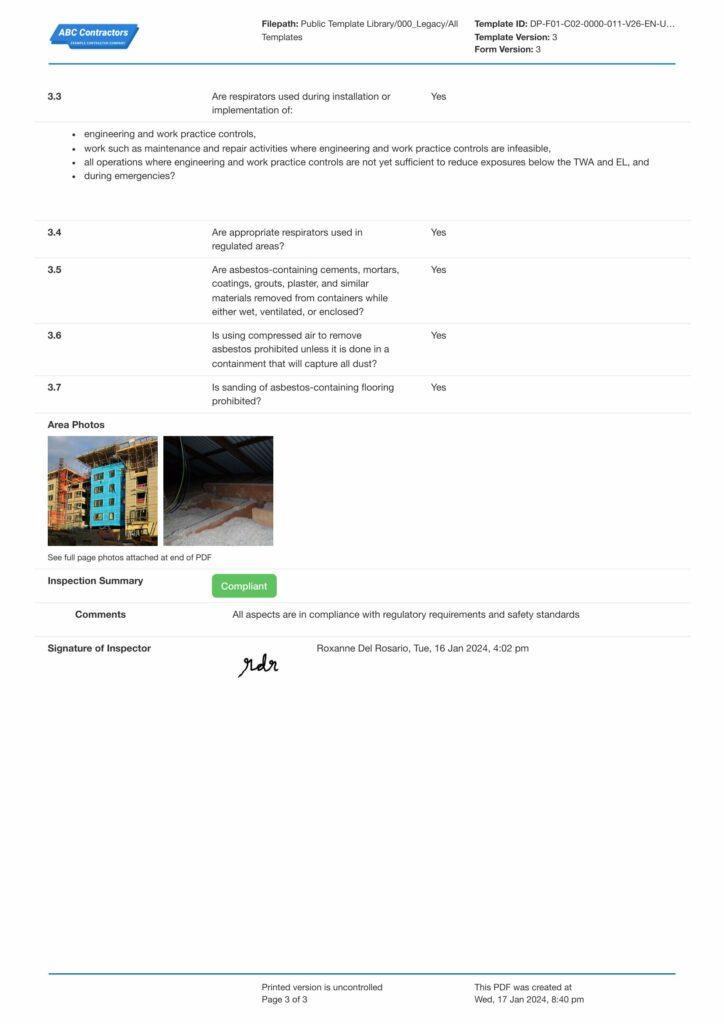Dashpivot Article – OSHA Asbestos Exposure Limits
OSHA Asbestos Exposure Limits
In this comprehensive asbestos safety guide, we will walk you through OSHA's asbestos exposure limits and how to stay compliant with OSHA asbestos regulation.

In the world of occupational safety, few substances get as much attention and regulation as asbestos. Asbestos, a mineral once used for its heat resistance and insulation, is a known health hazard causing mesothelioma, lung cancer, and asbestosis. OSHA has set strict rules to protect workers from asbestos exposure, with a focus on PELs and excursion limits.
OSHA’s Role in Asbestos Regulations
Asbestos exposure risks have been well known for decades, so the Occupational Safety and Health Act has implemented strict regulations to ensure workers are safe.
When workers are exposed to airborne asbestos fibres in the workplace, they are at risk of serious health effects, including lung cancer and other asbestos diseases.
The Environmental Protection Agency (EPA) and OSHA have worked together to create standards that protect workers through engineering controls, PPE, and medical surveillance.
Read more about OSHA Asbestos Regulations.
How to Identify Asbestos-Containing Materials
Asbestos-containing products and materials are still present in many building materials, especially in buildings built before the 1980s. These materials can contain various types of asbestos minerals, including chrysotile asbestos, amosite asbestos, tremolite asbestos, anthophyllite asbestos, and actinolite asbestos.
Knowing the asbestos content in these materials is key to proper management and hazard communication. When these materials are disturbed during renovation or demolition work, they can release dangerous airborne fibres, so proper work practices and asbestos abatement procedures are required.
Asbestos Use in Construction History
Asbestos was used widely in building materials because of its fire resistance and insulation properties, and historical asbestos deposits and mines had an abundance of these minerals, so they were added to many construction products. Knowing the history of asbestos explains why asbestos is still a problem in older buildings and why proper identification and management of asbestos-containing materials is key to workplace safety.
Asbestos Health Risks and Effects
Asbestos fibres are so small they are particularly dangerous when inhaled, and these fibres can only be properly seen with phase contrast microscopy and can become embedded in lung tissue over time, causing serious health effects.
Asbestos deposits and asbestos mines around the world have produced different types of asbestos minerals, each with its own properties and health risks. The National Institute for Occupational Safety and Health has done extensive research on how these fibres affect human health and developed the OSHA method for measuring asbestos concentrations.
How to Measure Asbestos Levels
Measuring airborne fibres is key to workplace safety and compliance, and the sampling period and method must follow strict protocols to meet PEL and excursion limits.
Employers must do initial exposure assessments and periodic monitoring to keep asbestos levels in check. The OSHA method provides a standardised way to collect and analyse air samples so results are consistent across different work environments.
To meet OSHA asbestos exposure limits, employers must do periodic monitoring and keep records of asbestos levels in the workplace in a properly documented asbestos register.
Initial exposure assessments establish the baseline; monitoring ensures levels are below PEL and excursion limits. OSHA requires PPE and engineering controls in areas where airborne fibres may be present, as these controls, plus proper warning signs and hazard communication, will reduce exposure and protect asbestos-exposed
OSHA Asbestos Exposure Limits
These limits were set to reduce further exposure and protect workers from asbestos contamination, and employers must implement full workplace controls, including engineering controls and work practices, to keep asbestos levels below these limits.
Permissible Exposure Limits (PELs)
OSHA’s primary way of regulating asbestos exposure is through Permissible Exposure Limits (PELs). The PEL for asbestos is 0.1 fibres per cubic centimetre of air (f/cc) averaged over an 8-hour work shift. This limit is set to reduce the risk of employees getting asbestos-related diseases.
Excursion Limit (EL)
OSHA also has an excursion limit, which is a higher concentration of asbestos fibres that workers can be exposed to for a short period. OSHA set an EL of 1.0 f/cc for 30 minutes, as this limit is important when short-term exposure may exceed the PEL.
How to Implement Asbestos Controls and Adhere to Asbestos Exposure Limits
Employers must do exposure assessments in areas where asbestos is present. If levels exceed the PEL, employers must implement engineering controls like ventilation systems and work practice controls to reduce airborne asbestos fibres. To ensure safety, proper PPE like respirators, coveralls, gloves, and foot protection must also be provided to workers.
Companies establish documents including their asbestos management plans, and then need to monitor and adhere to their own plans, as well as broader legislation including OSHA asbestos exposure limits.
Medical Surveillance and Training
OSHA requires medical surveillance for workers exposed to asbestos at or above the PEL or EL, and this includes periodic medical exams and lung function tests. Employers must also train workers on asbestos hazards and safe handling practices to ensure no one is overexposed to such limits.
Proper Record Keeping Against OSHA Asbestos Exposure Limits
Employers must keep records of asbestos exposure measurements and medical surveillance data for at least 30 years. An OSHA asbestos inspection checklist must also be made to help track what’s been inspected and signed off on for compliance and safety purposes. Doing proper record-keeping will help track exposure levels and ensure the long-term health of workers.
Standardise your OSHA Asbestos Inspections
Asbestos inspections are a critical part of OSHA compliance and asbestos exposure limits monitoring. This digital OSHA asbestos inspection checklist template makes it easy for your team to run asbestos inspections that meet your compliance requirements. The standardised form has sections for project location, details, inspector, and a checklist for your asbestos inspection questions. You can even add in any extra items you need for OSHA compliance in just a few clicks

Keep track of OSHA asbestos exposure limits with free templates like this
Why Technology Matters when Complying to OSHAs Asbestos Exposure Limits
In today’s digital age, managing asbestos-related safety protocols is more efficient with technology, as modern software platforms can help organisations track exposure levels, keep records, and meet OSHA standards better than ever before. These digital tools can automate monitoring schedules, generate reports, and send real-time alerts when exposure levels hit regulatory limits. Here’s why technology is essential in modern asbestos management:
More accurate data
Digital platforms can help eliminate the risks of manual data entry and paper-based record keeping. When monitoring asbestos concentrations and keeping exposure records, even small errors can have big consequences. Advanced software solutions will automatically capture and store sampling data, integrate results from phase contrast microscopy analysis, and keep accurate historical records of exposure levels. This is especially critical for meeting PELs and ELs and for an audit trail for regulatory inspections.
Real-time monitoring and immediate response
Traditional asbestos monitoring methods have delays between sampling, analysis, and response, but modern technology allows real-time monitoring systems to alert safety managers when airborne fibres hit danger levels. This instant feedback allows for quick implementation of engineering controls and PPE, potentially preventing exposure before it happens. Connected sensors and IoT devices can monitor workplace conditions 24/7, providing unparalleled visibility and worker protection.
Simplified Compliance and Record Keeping
Meeting OSHA asbestos requirements involves keeping lots of documentation, including exposure records, medical surveillance reports, and training certifications. Digital platforms centralise these records in secure, easily accessible databases. Automated reminders ensure monitoring is done on time, and built-in compliance checks verify all required documentation is complete and up to date. This eventually reduces administrative burden and improves overall OSHA compliance.
Worker Safety Through Predictive Analytics
Most importantly, modern technology allows for predictive analytics that can identify exposure risks before they become major problems. By analysing historical data, environmental conditions, and work activities, advanced software can forecast where asbestos concentrations will increase. This predictive capability allows organisations to take preventative measures rather than just reacting to exposure incidents after they happen. Safety managers can schedule more monitoring, deploy engineering controls, or modify work practices based on data-driven insights and provide better protection for asbestos-exposed workers.
Create processes around OSHA asbestos inspection recording and management
You can use this OSHA Asbestos Inspection app to manage the process of requesting, running, and signing off on asbestos inspections. You can view completed inspections in the Timeline view or the Register view, which you can use to filter or sort by various columns. Analyse asbestos inspection performance in the Analytics Dashboard to see pass/fail ratio, frequency of inspections, and more by team, project, or location.
In a Nutshell
Organisations can better protect their workers from asbestos exposure while keeping operations running smoothly with modern technology. Get in touch to see how digital safety management can change your approach to asbestos monitoring and compliance. Whether you’re managing a small renovation project or a large industrial operation, the right technology can make a big difference in worker health and compliance.
Ready to upgrade your asbestos safety management? Find out how digital can help you comply and protect your workforce better than ever.

OSHA Pre-Task Plan template
Ensure your OSHA Pre-Task Plans are compliant by using this free digital template.

OSHA form 300 & 300a template
Maintain your log of injuries and illnesses and your 300a summary with this free template.

OSHA Incident Report form 301 template
Properly document your injury and illnesses on site with this OSHA Injury and Illness Incident Report form 301 template.


